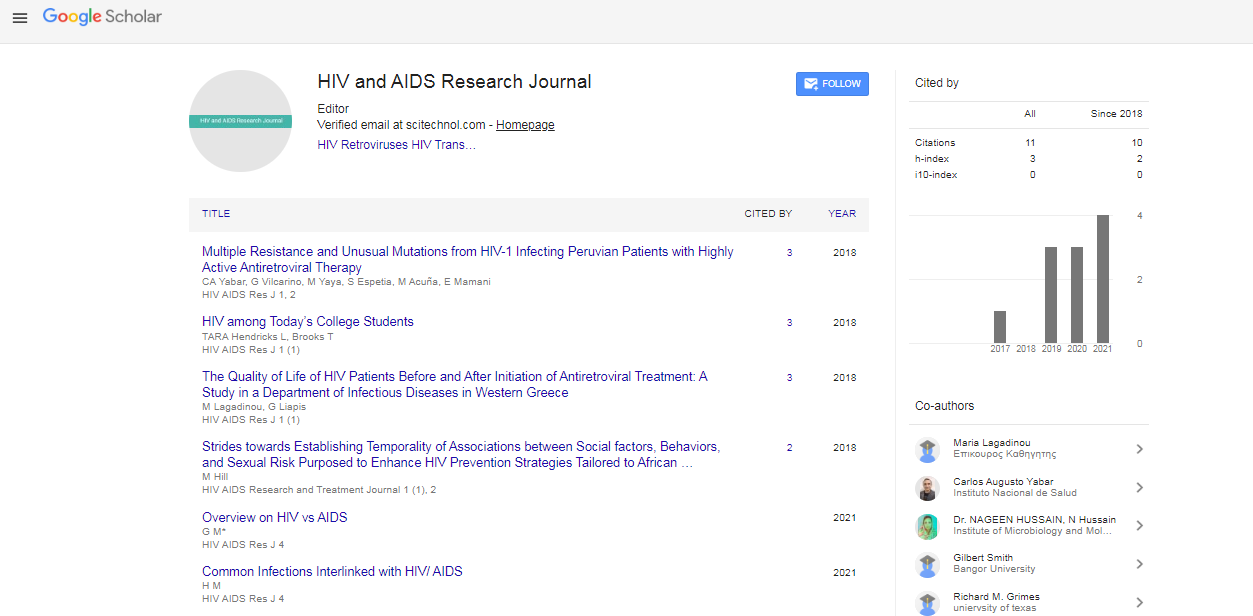Commentary, Hiv Aids Res J Vol: 6 Issue: 4
HIV Life Cycle: Insights into Viral Replication and Targets for Intervention
Richard Thomas*
1Department of Biotechnology, Osaka University, Osaka, Japan
*Corresponding Author: Richard Thomas,
Department of Biotechnology, Osaka
University, Osaka, Japan
E-mail: thomasrichard@uni.edu
Received date: 04 December, 2023, Manuscript No. HARJ-24-124118;
Editor assigned date: 06 December, 2023, PreQC No. HARJ-24-124118 (PQ);
Reviewed date: 20 December, 2023, QC No. HARJ-24-124118;
Revised date: 28 December, 2023, Manuscript No. HARJ-24-124118 (R);
Published date: 05 January, 2024 DOI: 10.4172/Harj.1000132
Citation: Thomas R (2024) HIV Life Cycle: Insights into Viral Replication and Targets for Intervention. HIV AIDS Res J 6:4.
Description
The Human Immunodeficiency Virus (HIV) employs a complex life cycle that underlies its ability to persistently infect and evade the human immune system. Understanding the sequential steps of the HIV life cycle is crucial for developing effective antiretroviral therapies and interventions.
Viral entry
The journey of HIV begins with viral entry into host cells. HIV predominantly targets CD4+ T lymphocytes and macrophages. The initial step involves the interaction of the viral glycoprotein, gp120, with CD4 receptors present on the surface of host cells. This binding induces conformational changes in gp120, enabling its interaction with co-receptors, primarily CCR5 or CXCR4, facilitating fusion of the viral envelope with the host cell membrane.
Reverse transcription and integration
Following entry, the viral RNA genome is released into the host cell cytoplasm. Reverse transcription, mediated by the enzyme reverse transcriptase, converts the viral RNA into a double-stranded DNA intermediate. This viral DNA migrates to the cell nucleus, guided by cellular machinery, where the enzyme integrase catalyzes its integration into the host cell genome, forming a provirus.
Transcription, translation, and assembly
Once integrated, the provirus may remain dormant or become transcriptionally active. Host cell machinery transcribes the proviral DNA into messenger RNA (mRNA), which serves as a template for the synthesis of viral proteins by ribosomes. These viral proteins, along with the viral RNA, are assembled at the host cell membrane into new virions.
Budding and maturation
The assembly process leads to the budding of immature virions from the host cell membrane. During this budding process, the viral protease enzyme becomes active, cleaving long chains of viral polyproteins into functional proteins, transforming the immature virion into a mature infectious virus particle. The newly formed mature virions then proceed to infect the other susceptible cells and continue the cycle of replication.
Potential targets for intervention
Understanding the HIV life cycle provides the valuable insights into potential targets for therapeutic intervention:
Entry inhibitors: Developing drugs that interfere with viral entry by targeting gp120, CD4 receptors, or co-receptors represents a promising strategy to prevent viral fusion and entry into host cells.
Reverse transcriptase inhibitors: Drugs targeting reverse transcriptase, such as Nucleoside and Non-Nucleoside Reverse Transcriptase Inhibitors (NRTIs and NNRTIs), disrupt the conversion of viral RNA into DNA, hindering viral replication.
Integrase inhibitors: Inhibiting integrase prevents the integration of viral DNA into the host genome, impeding the formation of the provirus and subsequent replication.
Protease inhibitors: Drugs targeting the viral protease disrupt the maturation process, preventing the cleavage of viral polyproteins into functional proteins, thereby inhibiting the production of infectious virions.
Conclusion
The intricate and sequential nature of the HIV life cycle provides multiple opportunities for targeted therapeutic interventions. Antiretroviral therapies that target different stages of the life cycle have significantly improved the management of HIV infection. However, the development of drug resistance and the persistence of latent reservoirs pose ongoing challenges. Continued research efforts directed towards novel therapeutic approaches and understanding the complexities of viral replication are crucial in the quest for more effective treatments and, ultimately, a cure for HIV/AIDS.
 Spanish
Spanish  Chinese
Chinese  Russian
Russian  German
German  French
French  Japanese
Japanese  Portuguese
Portuguese  Hindi
Hindi 